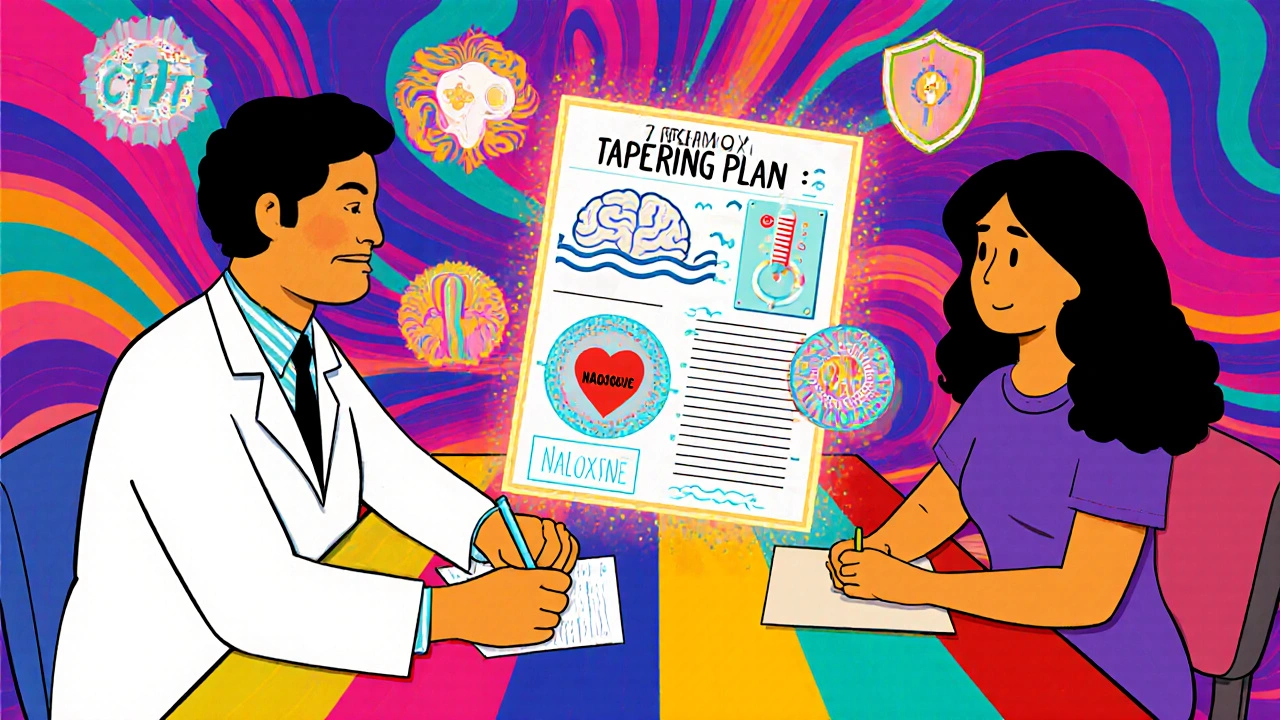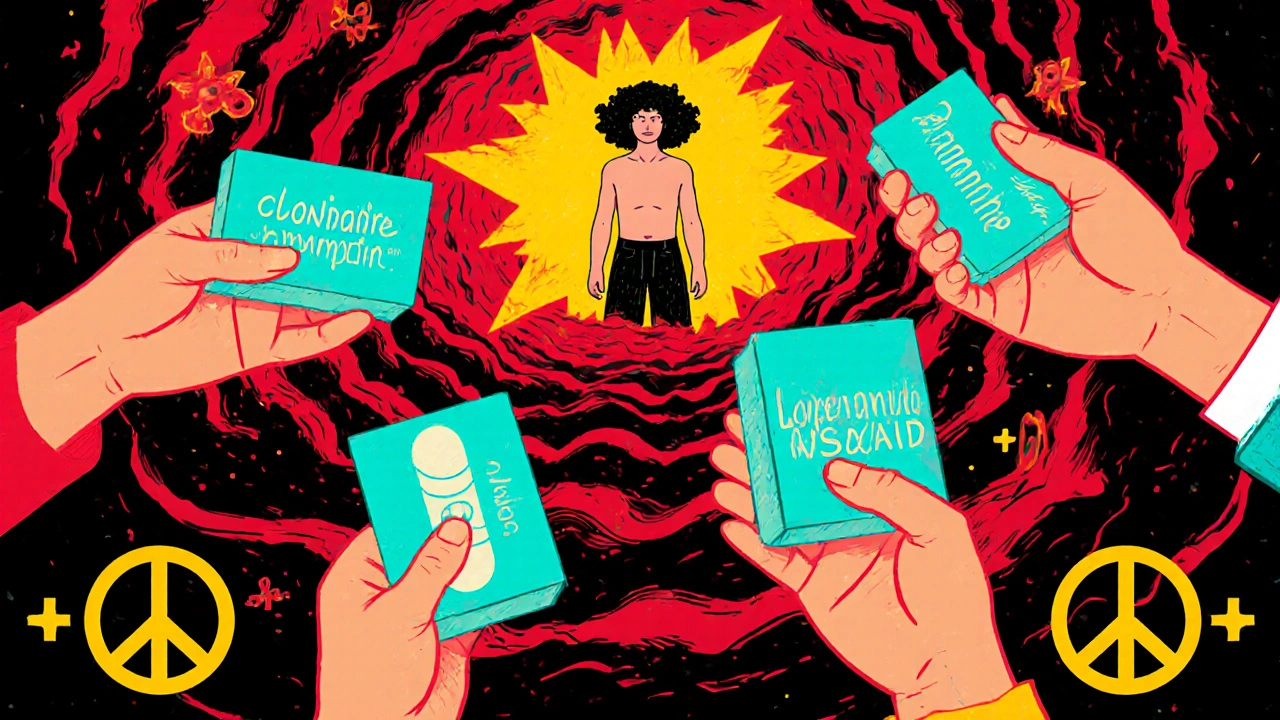Opioid Tapering Calculator
Create Your Safe Taper Plan
Important: This calculator follows CDC and VA/DoD guidelines. Always consult your doctor before starting a taper.
Your Personalized Taper Plan
Starting Dose: MME
Target Dose: MME
Taper Speed:
Estimated Duration: weeks
Minimum Reduction: MME/week
| Week | Reduction | Dose (MME) | Key Symptoms |
|---|
Warning: This taper exceeds safe guidelines. For doses over 120 MME, maximum reduction should not exceed 10% per week. Consult your doctor immediately.
Stopping opioids suddenly can be dangerous. For people who’ve been taking them for months or years, quitting cold turkey isn’t just uncomfortable-it can be life-threatening. The FDA recorded over 100 serious cases between 2012 and 2017 where patients suffered suicide attempts, severe withdrawal, or uncontrolled pain after abrupt discontinuation. That’s why tapering opioids safely isn’t optional. It’s a medical necessity.
Why Tapering Matters More Than You Think
When opioids are used long-term, your body adapts. It changes how your brain processes pain and pleasure. That’s dependence. It’s not addiction. Dependence means your nervous system expects the drug to be there. When you remove it too fast, your body goes into overdrive. Symptoms like anxiety, sweating, nausea, muscle cramps, and insomnia kick in hard. In some cases, people report feeling like they’re being pulled apart from the inside. The CDC’s 2022 guidelines make it clear: rapid tapering increases overdose risk by 68% and suicide attempt risk by 78%. That’s not a small number. It’s a red flag. Many providers, especially after the 2016 CDC guidelines, misinterpreted the advice to reduce opioid use as a mandate to stop them fast. Between 2017 and 2020, 12% of primary care doctors abruptly discontinued opioids for stable patients. At least 17 suicides were directly linked to that mistake. Tapering isn’t about cutting pills. It’s about giving your body time to readjust. It’s about protecting your life while managing pain.When Should You Consider Tapering?
Not everyone on opioids needs to taper. But if any of these apply to you, it’s time to talk to your doctor:- Your pain hasn’t improved in the last 3-6 months
- You’re taking more than 90 morphine milligram equivalents (MME) per day
- You’re mixing opioids with benzodiazepines or alcohol
- You’ve had an overdose or near-overdose
- You’re getting early refills or losing prescriptions
- You’re feeling foggy, drowsy, or depressed most of the time
- You’ve been on opioids for more than 6 months
How Fast Is Too Fast?
There’s no one-size-fits-all speed. But the science gives us clear boundaries.- Slow taper: Reduce by 10-25% every 1-3 weeks
- Fast taper: Reduce by 20-25% every few days to one week
- Never reduce by more than 10% per week if you’re on high doses (>120 MME)
What Happens During Withdrawal?
About 35% of people on long-term opioids experience moderate to severe withdrawal during tapering. Here’s what it typically looks like:- Anxiety (82% of cases)
- Insomnia (76%)
- Muscle aches and cramps (68%)
- Diarrhea and stomach cramps (59%)
- Sweating, chills, runny nose (54%)
- Nausea and vomiting (47%)

Medications That Help
You don’t have to suffer through this alone. There are safe, non-opioid tools to ease withdrawal:- Clonidine (0.1-0.3 mg twice daily): Reduces sweating, anxiety, high blood pressure, and rapid heart rate.
- Hydroxyzine (25-50 mg at bedtime): Helps with anxiety and sleep without the risk of addiction.
- Loperamide (2-4 mg as needed): Stops diarrhea without affecting the brain.
- NSAIDs or acetaminophen: Manage residual pain without opioids.
Protect Yourself: Naloxone Is Not Optional
Even if you’re tapering to get off opioids, your risk of overdose doesn’t disappear-it shifts. After reducing your dose, your tolerance drops. If you accidentally take a dose you used to handle easily, or if you relapse, you’re at higher risk. SAMHSA reports that 41% of overdose deaths during tapering happen in the first 30 days. That’s why naloxone should be prescribed at the start of any taper if you’re on more than 50 MME, have a history of overdose, or use benzodiazepines. Naloxone isn’t just for emergencies. It’s insurance. Keep it at home. Teach a family member how to use it. It’s a simple nasal spray. It saves lives.Success Isn’t Just About Stopping
Many people think the goal of tapering is to stop opioids completely. That’s not always realistic-or even the best outcome. In successful cases, the goal is often functional improvement. Are you sleeping better? Can you walk without constant pain? Are you less foggy? Are you able to spend time with your kids or go to work? Some people stabilize at 30-50 MME daily. Others switch to non-opioid pain treatments. A few go off entirely. But the ones who succeed are the ones who set goals with their doctor-not just numbers, but life changes.What Works Best: Integrated Care
Tapering alone doesn’t fix chronic pain. It just removes one tool. What you replace it with matters more. Studies show that combining tapering with cognitive behavioral therapy (CBT), physical therapy, and mindfulness practices cuts taper failure rates from 44% to just 19% at six months. That’s a massive difference. If you have anxiety, depression, or PTSD, those conditions need to be treated at the same time. Opioids often mask emotional pain. When you stop them, the pain comes back-sometimes louder. Therapy helps you learn to sit with it, not numb it. For people with opioid use disorder, buprenorphine may be part of the plan. It’s not replacing one addiction with another. It’s stabilizing your nervous system so you can heal.
Get It in Writing
A verbal agreement isn’t enough. Successful tapers almost always involve a written plan signed by both you and your provider. Oregon’s data shows that 87% of people who stuck with their taper had a signed agreement. Only 52% of those who didn’t had one. Why? Because writing it down forces clarity. It sets expectations. It protects you if things get hard. Your plan should include:- Your current dose and target dose
- The schedule (how much you’ll reduce and when)
- What symptoms to watch for
- When to call your doctor
- Emergency contacts
- Alternative pain strategies


Jessica Chambers
November 14, 2025 AT 15:04So many people think tapering is just about cutting pills. It’s not. It’s about rebuilding a nervous system that got hijacked by a chemical handshake that lasted too long. I’ve seen friends go from functionally paralyzed by pain to barely able to hold a cup of coffee because their doctor said, ‘You’re on too much. Stop.’ No plan. No support. Just a cliff. And then they vanished.
Clonidine and hydroxyzine? Yes. Naloxone? Absolutely. But the real magic is when someone sits with you and says, ‘Let’s find your new normal,’ not ‘Let’s get you off these.’
I’m not anti-opioid. I’m pro-human.
John Foster
November 15, 2025 AT 06:21There’s a quiet violence in how medicine treats chronic pain patients. We’re not addicts. We’re not lazy. We’re not weak. We’re people whose bodies learned to survive by relying on a molecule that wasn’t meant to be a permanent scaffold. And then, when the system decides we’ve outlived our usefulness, they yank the beam and wonder why we collapse.
The CDC guidelines were never meant to be a scalpel. They were meant to be a compass. But now they’re weaponized by bureaucrats who’ve never held someone’s hand through a 3 a.m. panic attack fueled by muscle spasms and the ghost of relief.
Tapering isn’t a checklist. It’s a conversation. And if your doctor won’t have it, find one who will. Your life isn’t a metric to be optimized.
Shyamal Spadoni
November 15, 2025 AT 08:55lol the fda stats are fake. they just wanna control us. why do you think they push naloxone so hard? its part of the big pharma plan to make us dependent on their other drugs. clonidine? hydroxyzine? those are just gateway drugs for the next phase. they want you hooked on prescriptions forever but call it ‘tapering’.
my cousin tried to quit and they gave him 5% per month. he cried for 3 weeks. then they said he was ‘noncompliant’. the system is rigged. dont trust your doctor. they work for the state.
Ogonna Igbo
November 15, 2025 AT 09:19you americans always think your way is the only way. in nigeria we dont need 8 hours of training to know when to reduce painkillers. if you can walk, you dont need opioids. if you can’t walk, you need surgery, not a pill. this whole thing is weakness dressed up as science.
we have real pain here - children with malaria, farmers with broken bones, no doctors, no clinics. you complain about tapering? you’re soft. stop being dramatic. just take less. your body will adapt. it’s not rocket science. it’s biology.
your ‘mental health’ is just an excuse to keep taking drugs. grow up.
BABA SABKA
November 15, 2025 AT 17:48Let me cut through the noise. This isn’t about opioids. It’s about the failure of modern medicine to treat pain as a systems problem. You don’t fix chronic pain by adjusting a dosage. You fix it by addressing the neuroplasticity, the trauma, the inflammation, the psychosocial isolation. The opioid is a bandage on a ruptured artery.
CBT + PT + mindfulness isn’t ‘alternative’. It’s the baseline. The fact that we’re still debating whether to pair tapering with real care is a national disgrace. We treat pain like a bug to be eradicated, not a signal to be understood.
And yes - naloxone is insurance. But so is a therapist who doesn’t flinch when you cry about losing your identity to a pill bottle.
Chris Bryan
November 17, 2025 AT 12:59They’re lying about the 68% increase in overdose risk. That number was pulled from a study funded by the Gates Foundation. They want you scared so you’ll take their ‘alternative’ drugs - gabapentin, ketamine, cannabis - which are all gateway to federal control. The VA/DoD guidelines? They’re written by bureaucrats who’ve never held a job that hurt their back.
My uncle tapered for 18 months and ended up worse. Now he’s on disability and a therapist. They told him he was ‘traumatized’. Bullshit. He was just tired of being treated like a junkie. The real problem? The government doesn’t want you healthy. They want you dependent - on them.
Jonathan Dobey
November 19, 2025 AT 12:50There’s a poetic tragedy in how we’ve turned healing into a spreadsheet. We reduce a man’s dose by 10% and call it ‘progress’ while his soul screams in the quiet hours between 2 and 4 a.m., when the body remembers what the mind has been trained to forget.
The opioid wasn’t the villain. It was the last loyal friend in a world that had long since stopped listening. Tapering isn’t about quitting drugs. It’s about learning to live with the silence that follows. And most of us? We’re not ready for silence.
The real miracle isn’t naloxone. It’s the nurse who says, ‘I’m here,’ not ‘Here’s your script.’
ASHISH TURAN
November 20, 2025 AT 06:36One sentence: Slow tapers work because biology doesn’t care about your calendar.